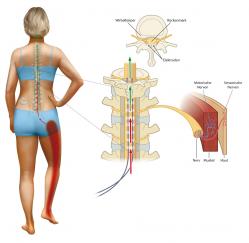operative Schmerztherapie
Electronical stimulation procedure DCS
Operational pain Therapy
Synonyms: DCS( dorsal colum stimulation), SCS (spinal cord stimulation)
Indication:
FBSS: “failed back surgery syndrome”à pain after an operation of the vertebral column
CRPS: “complex regional pain syndrome” àMorbus Sudeck or after an reflex dystrophie
Phantom pain, posttherapeutical neuralgia, peripheral neuropathia
Angina pectoris
PAVK: peripheral artery occlusive disease
With the help of stimulatory electrodes it is possible to stimulate the peripheral nerves and the spinal cord to treat chronic nerve pain. Due to the electrodes it comes to an irritation of the nerve which deplaces the nerve pain. This effect can stay longer than the stimulatory phase.
During an ambulant operational intervention the surgeon will make an approx. 4 cm. long cut in the area of the lumbal spine. This procedure is completely painless due to local anesthetics. The surgeon will insert a sonde and place it on the cord skin. With the help of the patient and some stimulation the surgeon will place the sonde at the area where the pain originates. The pain will be erased with individually adjustable electrical stimulation. The patient will feel some prickling which most of the patients describe as comfortable. The nerve bundle will be blocked and the pain cannot be transferred to the brain. Additionally the body gets stimulated to produce endorphins which have a pain limiting character as well.
Implantation:
In the test phase we will applicate a trial electrode epidurally. The patient will be supplied with a external trial stimulator. In the following days we will perform some test to verify the procedure. After approx. 3 days the trial electrode will be removed. If the neurostimulation was positiv we will implant a final stimulator after some weeks.
Risks:
The risks are very few like an infection. In very rare cases the electrode can move which decreases the positive effect of the stimulation.
Peripheral nerves and the spinal cord can be stimulated with stimulation electrodes to relieve chronic nerve pain. Nerve pain is suppressed by the nerve stimulation triggered by the electrode. This effect continues beyond the stimulation phase.
The stimulation effect is first observed in a test procedure. If the result is positive, a stimulation system that is controlled within certain limits by the patient can be implanted. This type of surgery does not have to be performed under general anesthesia. There are computer-controlled, implantable devices or devices that are worn on the outside and adjusted manually.
During the outpatient procedure, a probe is pushed under the local anesthetic using a 4 cm long incision in the area of the lumbar spine onto the spinal cord skin in the spinal canal and placed under stimulation and cooperation of the patient so that the nerve root and thus the associated pain area are reached. The pain is relieved by individually adjustable electrical stimulation. As a result, the patient feels a fine tingling sensation, which in most cases is felt to be very pleasant. This blocks the nerve fiber so that the pain can no longer be passed on. In addition, the body is stimulated to produce the body's own endorphins (analgesic substances).
he probe is tested for success for a week. The patient can set different currents at home and, if the results are optimal, the probe is connected to a pulse generator (telemetric) to be programmed through the skin in a second general anesthetic procedure. This device is implanted in the fatty tissue of the middle abdomen. The patient can switch the device on and off using a magnet and adjust the stimulation strength to suit individual needs. On the medical side there is the possibility of programming through the skin (telemetry), so that a local intervention in the mid-abdominal area to change the battery may only be necessary after several years after the battery is exhausted.
The newer stimulators are battery operated and can be charged through the skin.
Implantation:
For this purpose, a test electrode is initially applied epidurally in local anesthesia in a test phase on the right side. The patient is then provided with an external trial stimulator for a few days; multiple tests are carried out to verify the success of the method. The sample electrode is removed after about three days. If the response to the neurostimulation is positive, the final stimulator is implanted under general anesthesia after just a few weeks.
Based on our experience, we prefer systems with a rechargeable battery because they have a service life of more than 20 years, are significantly smaller and, thanks to the use of a higher energy density, are also significantly more powerful.
Risks:
The risks of the method are low, e.g. Infections. An electrode migration is occasionally observed, so that the success of the treatment deteriorates. Technical "ailments" such as electrode breaks and insulation defects are rare today.


